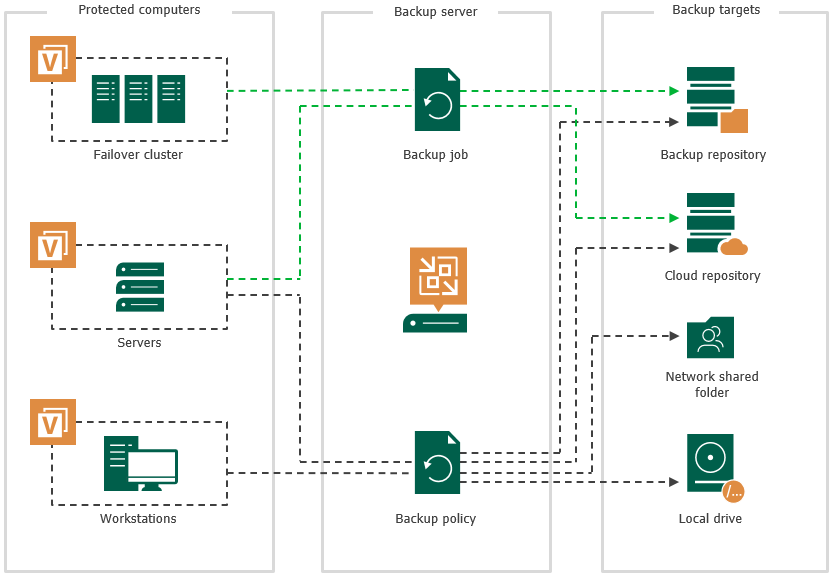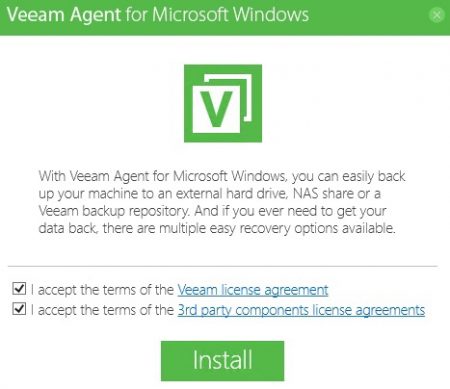

Replication is also a good fit for mission-critical applications that require synchronization of the latest changes. Replication focuses on providing a company with the most up-to-date version of data for the shortest RTO possible. Instead, it will revert to a status dating from several hours or days ago, depending on your backup schedule.

Restoring a backup will not necessarily revert your server to the most recent version of your data. Backup should also be considered as a standalone option if your company can afford some downtime and restoration to the last backup. Backup is useful if you are looking for data retention, data corruption prevention, and other concerns that can be avoided with the creation of multiple copies of your data. What Are the Benefits of Each Option?īackup focuses on compliance and granular recovery, such as recovering a single VM created several years earlier.
#Veeam backup software#
On the other hand, the only additional tool required for backup other than software is a storage device and a location for the storage media i.e., VCSP onsite server. Replication requires investment in another identical, infrastructure to keep the VM copy in sync with the original VM. Both replication and backup require the use of their respective software. Since prices for backup and replication vary depending on the amount of data, we’ll base our comparison on infrastructure requirements. How Do Prices Compare for VM Replication and Backup? This will save you time and money when a disaster occurs.
#Veeam backup pro#
On average, you can expect data to be recovered within minutes.Ī pro tip: Deal with VCSPs who can provide you with a free backup restoration to their infrastructure. This is all because the data is in its original size and ready to be used on hardware that is identical to the original. When configured with redundant server infrastructure, replication can also provide near to instantaneous RTO. Replication provides applications with near to zero RPOs. Replication provides an alternative solution to companies with low tolerance for time and data loss. However, in majority of cases, downtime results in hig In some businesses, one day of dysfunctional systems may be tolerable. Depending on the data size, restoration of a backup will generally take much longer to be up and running than replication. You should consider that data restoration takes some time due to data decompression. RPO is how recent the information must be restored to avoid harmful data loss for the company after a disaster.īacked up data will only be as recent as the last time it was created, so when you rely on backups for your DR strategy, the RPO will be higher compared with replication. RTO is the threshold for how quickly you need to have an application’s information restored. The effectiveness of a Disaster Recovery Plan is measured by a Recovery Time Objective (RTO) and Recovery Point Objective (RPO). After the first replication, further replications will simply synchronize the changes that were made since the last replication. Unlike backups, replicas are stored in the original VM size. It synchronizes this copy with the original VM. Virtual machine replication is the creation of an exact copy of the Virtual Machine in the native format on a spare host. Backup uses compression and deduplication (removing duplicated entries of data). Backing up your data is an essential part of a Disaster Recovery (DR) plan.

#Veeam backup how to#
Learn how to turn a profit from disaster recovery with Veeam Cloud Connectīackup refers to copying files or data blocks to some external media or to a secondary site for preservation in case of a malfunction We will define the options, discuss their recovery efficiencies, present their costs, and outline their benefits. We’ve put together a simple guide that will empower you to make an educated decision on a backup and/or replication solution for your business. What is Veeam Backup? What is Veeam Replication? Which is the right solution for you?


 0 kommentar(er)
0 kommentar(er)
